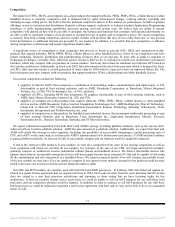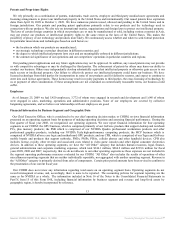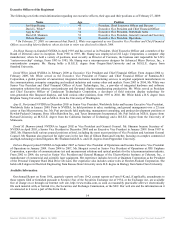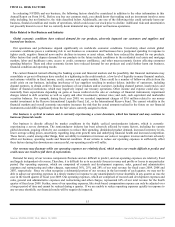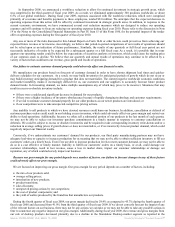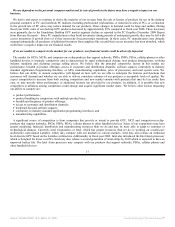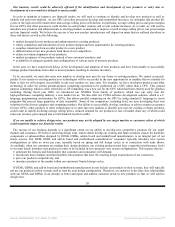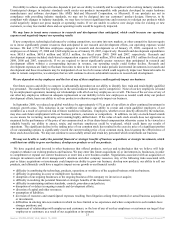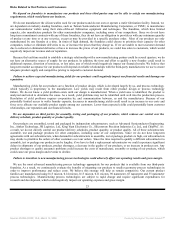NVIDIA 2009 Annual Report Download - page 23
Download and view the complete annual report
Please find page 23 of the 2009 NVIDIA annual report below. You can navigate through the pages in the report by either clicking on the pages listed below, or by using the keyword search tool below to find specific information within the annual report.
We are subject to risks associated with international operations which may harm our business.
We conduct our business worldwide. Our semiconductor wafers are manufactured, assembled, tested and packaged by third-parties
located outside of the United States. We generated 87%, 89% and 86% of our revenue for fiscal years 2009, 2008 and 2007,
respectively, from sales to customers outside the United States and other Americas. As of January 25, 2009, we had offices in fifteen
countries outside of the United States. The manufacture, assembly, test and packaging of our products outside of the United States,
operation of offices outside of the United States, and sales to customers internationally subjects us to a number of risks, including:
• international economic and political conditions, such as political tensions between countries in which we do business;
• unexpected changes in, or impositions of, legislative or regulatory requirements;
• complying with a variety of foreign laws;
• differing legal standards with respect to protection of intellectual property and employment practices;
• cultural differences in the conduct of business;
• inadequate local infrastructure that could result in business disruptions;
• exporting or importing issues related to export or import restrictions, tariffs, quotas and other trade barriers and restrictions;
• financial risks such as longer payment cycles, difficulty in collecting accounts receivable and fluctuations in currency exchange
rates;
• imposition of additional taxes and penalties; and
• other factors beyond our control such as terrorism, civil unrest, war and diseases such as severe acute respiratory syndrome and
the Avian flu.
If sales to any of our customers outside of the United States and other Americas are delayed or cancelled because of any of the
above factors, our revenue may be negatively impacted.
Our international operations in Australia, China, Finland, France, Germany, Hong Kong, India, Japan, Korea, Russia, Singapore,
Sweden, Switzerland, Taiwan, and the United Kingdom are subject to many of the above listed risks. Difficulties with our
international operations, including finding appropriate staffing and office space, may divert management’s attention and other
resources any of which could negatively impact our operating results.
The economic conditions in our primary overseas markets, particularly in Asia, may negatively impact the demand for our products
abroad. All of our international sales to date have been denominated in United States dollars. Accordingly, an increase in the value of
the United States dollar relative to foreign currencies could make our products less competitive in international markets or require us
to assume the risk of denominating certain sales in foreign currencies. We anticipate that these factors will impact our business to a
greater degree as we further expand our international business activities.
If our products do not continue to be adopted by the desktop PC, notebook PC, workstation, high-performance computing,
netbook, personal media player, or PMP, personal digital assistant, or PDA, cellular handheld device, and video game console
markets or if the demand for new and innovative products in these markets decreases, our business and operating results would
suffer.
Our success depends in part upon continued broad adoption of our processors for 3D graphics and multimedia in desktop PC,
notebook PC, workstation, high-performance computing, netbooks, PMPs, PDAs, cellular handheld devices, and video game console
applications. The market for processors has been characterized by unpredictable and sometimes rapid shifts in the popularity of
products, often caused by the publication of competitive industry benchmark results, changes in pricing of dynamic random-access
memory devices and other changes in the total system cost of add-in boards, as well as by severe price competition and by frequent
new technology and product introductions. Broad market acceptance is difficult to achieve and such market acceptance, if achieved, is
difficult to sustain due to intense competition and frequent new technology and product introductions. Our GPU and MCP businesses
together comprised approximately 75%, 79% and 77% of our revenue during fiscal years 2009, 2008 and 2007, respectively. As such,
our financial results would suffer if for any reason our current or future GPUs or MCPs do not continue to achieve widespread
adoption by the PC market. If we are unable to complete the timely development of new products or if we were unable to successfully
and cost-effectively manufacture and deliver products that meet the requirements of the desktop PC, notebook PC, workstation,
high-performance computing, netbook, PMP, PDA, cellular phone, and video game console markets, we may experience a decrease in
revenue which could negatively impact our operating results.
Additionally, there can be no assurance that the industry will continue to demand new products with improved standards, features or
performance. If our customers, OEMs, ODMs, add-in-card and motherboard manufacturers, system builders and consumer electronics
companies, do not continue to design products that require more advanced or efficient processors and/or the market does not continue
to demand new products with increased performance, features, functionality or standards, sales of our products could decline and the
markets for our products could shrink. Decreased sales of our products for these markets could negatively impact our revenue and our
financial results.
19
Source: NVIDIA CORP, 10-K, March 13, 2009 Powered by Morningstar® Document Research℠




